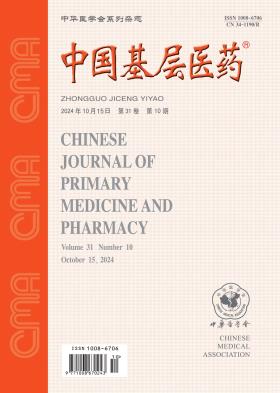Alternate application efficacy of high-frequency oscillatory ventilation and constant-frequency mechanical ventilation in the treatment of premature infants with respiratory distress syndrome
引用次数: 0
Abstract
Objective To investigate the alternate application efficacy of high-frequency oscillatory ventilation and constant-frequency mechanical ventilation in the treatment of premature infants with respiratory distress syndrome. Methods From April 2015 to August 2017, 174 premature infants with respiratory distress syndrome were chosen in this research and randomly divided into three groups.CF group was treated with constant-frequency mechanical ventilation, HF group was treated with high-frequency oscillatory ventilation, AP group was treated with alternate application of constant-frequency mechanical ventilation and high-frequency oscillatory ventilation.After treatment, the oxygen time, mechanical ventilation time, oxygenation, complications and survival in the three groups were compared. Results The oxygen time, mechanical ventilation time of the AP group were shorter than those of the HF group and the CF group, the differences were statistically significant (all P 0.05). Conclusion Alternate application of high-frequency oscillatory ventilation and constant-frequency mechanical ventilation in the treatment of premature infants with respiratory distress syndrome can improve oxygenation, shorten oxygen time and mechanical ventilation time, with good safety. Key words: Respiratory distress syndrome; Premature infants; Constant-frequency mechanical ventilation; High-frequency oscillatory ventilation高频振荡通气与恒频机械通气交替应用治疗早产儿呼吸窘迫综合征的疗效
目的探讨高频振荡通气与恒频机械通气交替应用治疗早产儿呼吸窘迫综合征的疗效。方法选取2015年4月~ 2017年8月收治的呼吸窘迫综合征早产儿174例,随机分为3组。CF组采用恒频机械通气治疗,HF组采用高频振荡通气治疗,AP组采用恒频机械通气与高频振荡通气交替应用。治疗后比较三组患者供氧时间、机械通气时间、供氧情况、并发症及生存率。结果AP组供氧时间、机械通气时间均短于HF组和CF组,差异均有统计学意义(P < 0.05)。结论高频振荡通气与恒频机械通气交替应用治疗早产儿呼吸窘迫综合征可改善氧合,缩短供氧时间和机械通气时间,安全性好。关键词:呼吸窘迫综合征;早产儿;恒频机械通气;高频振荡通气
本文章由计算机程序翻译,如有差异,请以英文原文为准。
求助全文
约1分钟内获得全文
求助全文
来源期刊
CiteScore
0.10
自引率
0.00%
发文量
32251
期刊介绍:
Since its inception, the journal "Chinese Primary Medicine" has adhered to the development strategy of "based in China, serving the grassroots, and facing the world" as its publishing concept, reporting a large amount of the latest medical information at home and abroad, prospering the academic field of primary medicine, and is praised by readers as a medical encyclopedia that updates knowledge. It is a core journal in China's medical and health field, and its influence index (CI) ranks Q2 in China's academic journals in 2022. It was included in the American Chemical Abstracts in 2008, the World Health Organization Western Pacific Regional Medical Index (WPRIM) in 2009, and the Japan Science and Technology Agency Database (JST) and Scopus Database in 2018, and was included in the Wanfang Data-China Digital Journal Group and the China Academic Journal Comprehensive Evaluation Database.

 求助内容:
求助内容: 应助结果提醒方式:
应助结果提醒方式:


